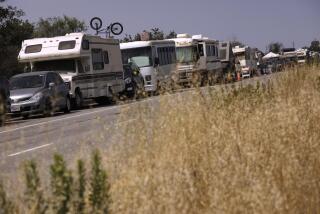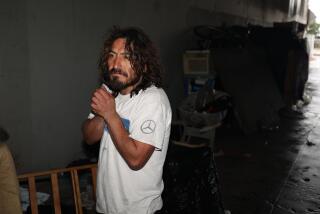West L.A. winter shelter for homeless opens early
Matthew Dunn, 34, flashed his best Popeye the Sailor grin as he boarded the van from Venice Beach to the Westside winter shelter.
Julie “Julez” Arispe, 42, roused from a beer-induced slumber on the grass near Windward Avenue, clambered aboard with her guitar and bags of belongings and launched into an upbeat rendition of Janis Joplin’s “Mercedes Benz.”
With darkness bringing a damp chill to Ocean Front Walk one recent evening, both appeared relieved at the prospect of a hot meal and a cot inside the West Los Angeles National Guard Armory, about 7 miles inland.
PHOTOS: West L.A. emergency shelter
Facing an influx of homelessness in Venice and Westchester, Los Angeles opened an emergency cold-weather shelter at the facility on Oct. 17, 6 1/2 weeks earlier than the usual Dec. 1 opening. Each night, a van transports dozens of individuals to the shelter, where they can shower, watch TV, chat and sleep without fear, before returning to the streets in the morning.
The early opening was prompted by calls that began pouring in to the office of Councilman Bill Rosendahl in mid-September. Merchants, landlords and residents complained about a sudden influx of transients at Venice Beach and the Westchester Recreation Center. The newcomers were rowdy, the callers said; they were defecating in public and harming older, chronically homeless characters who had long bedded down near Ocean Front Walk.
A team from the Los Angeles Homeless Services Authority conducted an overnight survey in the area and found 202 people sleeping on the streets, far more than usual. (In January 2011, the agency estimated that 51,340 homeless people lived in Los Angeles County.)
“What we saw were a lot of single people … that need special attention,” said Jeanette Rowe, the authority’s director of homeless services. They were unemployed and underemployed. For the most part, they were not taking advantage of social services. They smoked marijuana and drank alcohol excessively. Notably, nearly 70% were from out of state — Massachusetts, Arkansas, New York, Florida, Costa Rica, France. By day, they blended in with tourists. By night, they were disruptive.
The city came up with $110,000 from federal block grant money and a Rosendahl program aimed at providing housing for people living in vehicles. The Los Angeles Homeless Services Authority, which is funded by the city and Los Angeles County, sought bids from service providers that could ramp up quickly to organize a Westside shelter. First to Serve Inc., a nonprofit organization that offers substance abuse treatment, transitional housing and job placement, got the assignment.
About a dozen First to Serve counselors and volunteers were on hand Wednesday night to greet two vanloads of individuals from Venice and Westchester.
As Arispe waited in line to check in, she strummed her guitar and sang: “Happy and homeless, I must confess. Don’t need a roof, I just need some … rest.” Volunteers in search of weapons or contraband patted down each individual and inspected every backpack and suitcase.
Once inside, all 48 of the men and women answered an extensive survey. How much schooling did you have? What circumstances caused your homelessness? Do you have a drug or alcohol problem? Do you feel you have a mental health problem? Have you been a victim of domestic violence? Are you receiving social services? The answers will become part of a federal Department of Housing and Urban Development database designed to track the use of homeless programs and social services.
Many people said they had lost jobs or suffered from illness or injuries. Some exhibited signs of mental illness.
Dunn said he had been diagnosed with lung cancer and had moved to Los Angeles from Miami, where he didn’t “like the storms or the way my family treated me.”
One 42-year-old woman with long, blond hair described herself as a former childhood actor whose parents were Hayley Mills and Redd Foxx.
Olive drab-colored cots were set up on the concrete floor of the brightly lighted long hall; 38 men were in one area and 10 women in another. A guardsman and volunteers remained at the facility throughout the night. Camouflage netting draped around the armory hall added an oddly decorative touch. A volunteer handed out blankets.
At one end of the hall, the men and women sat at a long table and ate a dinner of fried turkey, yams and green beans off green plastic trays. The atmosphere was calm. “They like the security and quiet,” said the Rev. Richard Reed, First to Serve’s executive director.
Several said they were relatively new to life on the streets.
Maria Hill, 40, arrived recently from Detroit after a three-day trip by Greyhound bus. She stayed in a hotel for a time but ran low on money. Clutching two cellphones and a tightly rolled wad of bills (“my last $80”), Hill found it impossible to sleep al fresco. “It was so scary and cold, and there were so many homeless people,” she said tearfully. “All I need is work.”
The shelter has been a godsend. “They talk to us and help us try to find jobs,” Hill said. “They are so good to us.”
After a hot shower, Arispe settled onto a cot to discuss entering a detox program. “All it takes,” case manager Christiana Henson told her, “is to need and want to change.”
“I’m asking for help,” Arispe said, wiping tears from her cheeks. “I’ve been on the road too long. I’ve been drunk too long.”
The lights went out at 10. By 5:45 the next morning, the 48 men and women were headed back to the beach on the van, with a sack lunch.
On Dec. 1, 16 other winter shelters will open throughout the county and operate until mid-March. Including West Los Angeles, which will have 160 beds beginning Dec. 1, the facilities will provide a total of 1,487 beds.
PHOTOS: West L.A. emergency shelter
More to Read
Start your day right
Sign up for Essential California for news, features and recommendations from the L.A. Times and beyond in your inbox six days a week.
You may occasionally receive promotional content from the Los Angeles Times.







